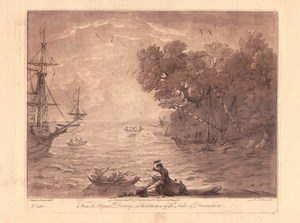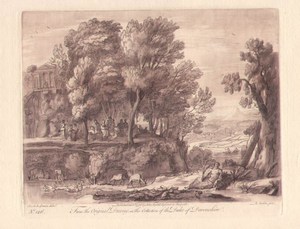|
Claude le
Lorrain (1600-1682) - French School
Perhaps the most important landscape artist in France. Learned and
worked in Rome where he imported his exquisite atmosphere and feeling
of light in his wonderful landscapes.
|
Richard Earlom
(1743-1822) - English School
One of the finest mezzo tint artists ever. A technique for the engraving
of washed master drawings he brought to perfection.
|
|

View of the Sea, with
an effect of the sun. Claude himself is seen drawing on the shore
|

Ditto, with mount Parnassus
and the Muses, the River Helicon personified, under the Character of a
River God below.
|
|
LIBER
VERITATIS
Was a group of landscape drawings done by Claude Lorrain who are for a
great deal in the possession of the court of Great Britain.The group of
mezzo tints done by Richard Earlom was his first major work. It was
published in 1777 by John Boydell. Measures 8.30 by 10.30 inches in a
larger sheet of laid paper. Condition is perfect with a good sharp
impression, a marvellous tonality and very sharp clear plate border
impression still with occasional blur.
|
Mezzotint:
This technique of engraving was invented in 1642 by Ludwig van Siegen.
The whole surface of the plate is first made rough by an instrument and
then the artist works his design in the plate by wiping out the rough
area's more or less to become more or less white area's. This technique
builded up a reputation in the 17th century but is above all a technique
of the eighteenth century. It was especially a spatiality of the angel
Saxon world. Mezzotint prints fetch higher prices because of the
picturesque view (like painted) and the more labour-intensive method to
make them. It was also called "a la maniere noire" |